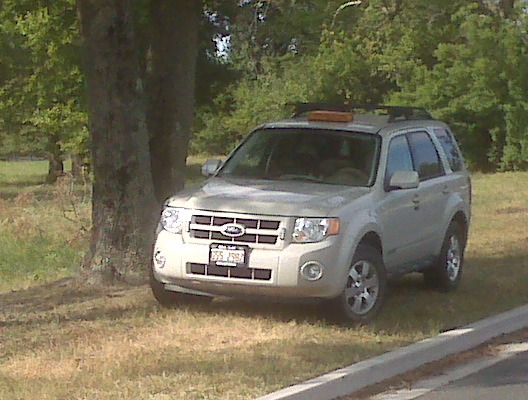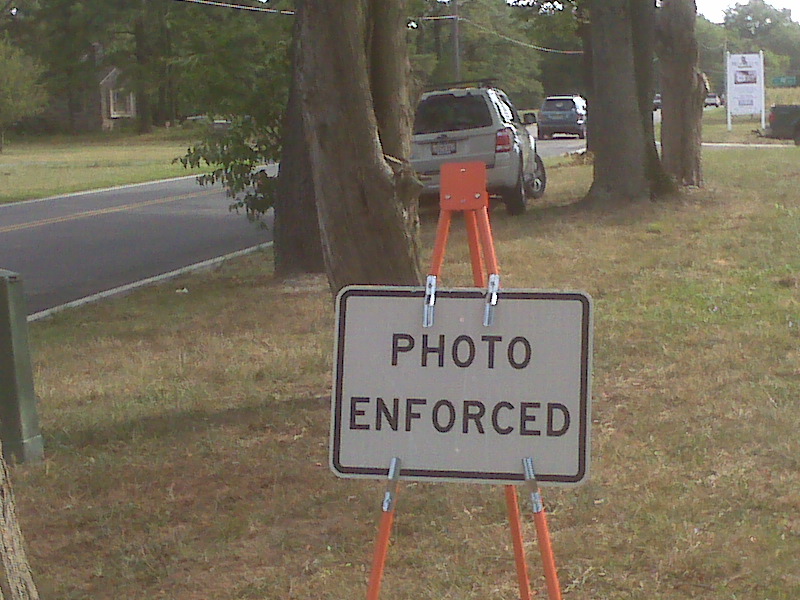In part 1 yesterday, I detailed how the city of Fruitland came to acquire its video speed recording equipment through changes in state law and the ordinance enacted to allow the city to secure a contract with the equipment vendors.
Here is what they received:

In the second picture, the required warning sign is shown along with the Escape’s location that day. Hang on because that’s important.

According to the Maryland State Highway Administration’s “School Zone Automated Speed Enforcement Information” pamphlet, a school zone is designated by the SHA as follows:
SHA defines a “School Zone” as a segment of highway located within a School Area that is:
- Routinely used by pupils for access to or egress from school buildings or grounds,
- Established by official action, and
- Designated by appropriate signs.
I emphasized “and” because that’s the important factor.
Yesterday I did a little bit of field investigation regarding the two schools in Fruitland, Fruitland Intermediate on West Main Street and Fruitland Primary on North Division Street. The posted school zones are as follows:
Fruitland Intermediate: along West Main Street from a point just west of the intersection with Business U.S. Route 13 to the corner of Moore Street.
Fruitland Primary: along North Division Street from a crosswalk just north of Anderson Street to the corner of Elizabeth Street.
In both cases, there are signs which denote the speed limits as “photo enforced.”
However, the location of this speed camera was well outside the posted school zone!
I’m sure Fruitland may argue that this stretch of road falls within the 1/2 mile radius allowed for school zone enforcement, and being that Fruitland Primary is just down the street they would be correct. However, the SHA guide notes:
The Maryland Annotated Code (TR § 21-803.1) allows School Zones to be established within a one-half mile radius of any school. However, this does not mean that all roads within a one-half mile radius of a school are considered School Zones. The SHA, or the local authority having jurisdiction over the road, must officially establish a School Zone and designate it with the appropriate signs before it becomes a School Zone.
School zones should not be established solely for the purpose of installing speed cameras. Similarly, all school zones do not automatically qualify for speed cameras. Speed camera deployments should be based on a traffic safety study. (Emphasis in original.)
My photo source informed me that, not only were the pictures taken outside the school zone but during a period when the kids are out of school! There’s no question that school safety was less of a factor in this case than fund generation.
The only “out” is whether this was an active work zone for construction at the time, since the ordinance as written was for a “speed monitoring system in each school zone and work zone.” Perhaps a test case is in order, depending on where one of the nearly 100 scofflaws was photographed and at what time. The local law clearly states that these cameras are only for school zones and work zones and the road appears to be fully open, without any orange construction barrels or other signage associated with a construction zone.
But this also points out the importance of monitoring local government. A group like Americans for Prosperity would normally be all over this item, but it slipped through the cracks. Certainly I made the case to Wicomico County officials that I was dead-set against the speed camera idea after SB277 passed last year, but the city of Fruitland obviously didn’t get a similar message.
There is one other remedy, though, and that is through the ballot box. Last week the city of Fruitland began soliciting candidates for its municipal elections this October. As it so happens, three of those who voted in favor of adopting speed cameras will be on the ballot, and it certainly gives pro-freedom candidates a chance to win office.
The filing deadline is September 6th, so if you don’t appreciate the City Council pulling one over on the motorists in Fruitland in the effort to squeeze a little extra revenue out of them, here is your opportunity to make a change. The election occurs October 4, 2010.


My wife received one of these Red Speed tickets from Fruitland. I was furious for the fact that she wasn’t even driving her car do to medical reasons. I did the same research about the law that Maryland enacted. I also did several drive bys and found that the Ford Escape was outside of the posted school zone. The ticket was also issued in August while school was not in secesion. I would have gladly paid the fine if an officer had stopped me while I was driving the car. I could have faced the accuser. But that day me and a friend drove through that area several times while running errends for my wife. Suppose a drunk, someone on drugs, a thief, or an unliscensed driver was speeding through the area. They didn’t get stopped by an officer and taken off the road for the safety of the innocent. This isn’t about slowing people down. The officer sits in an office reviewing tapes while people speed on by. This is about collecting revenue(another tax). Folks, this is just another way to help pay for the new retirement plan that Fruitland Police officers want.